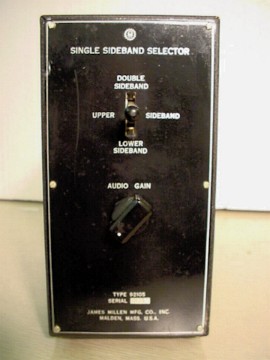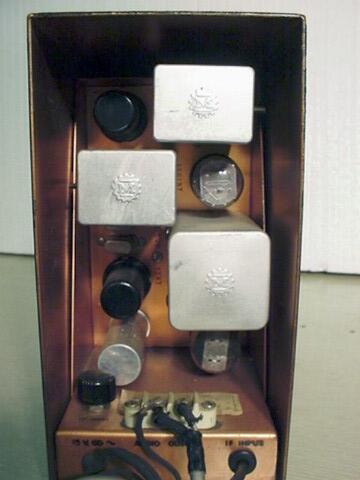

92105 Single Sideband Selector


|
The Millen 92105 is an external replacement IF and audio section dedicated for the
reception of single-sideband signals. The 92105 was based on a design by J.L.A.
McLaughlin and appeared in the April 1948 issue of QST magazine. This unit uses
what is termed a double-oscillator sideband inverter. Basically the user would tap
the IF signal from their receiver. Usually this was done by simply wrapping insulated
wire around the plate lead of the detector tube. This IF signal would be mixed with
either a crystal frequency 50Kc above or below the IF frequency of the receiver.
The 92105 came delivered for a 455kc IF, but simply changing the crystals to values
+/- 50Kc from your receivers IF frequency would make this unit operational on just
about any other receivers IF. After WWII crystal prices were dropping drastically. Military needs brought many of crystal manufacturers big business as well as offering new opportunity for start-ups. With the war over the competion for sales ment sell cheaper or close your doors. Both happened! However, the amateur radio market got the benefit of these price reductions and thus a unit like the 92105 could be built, bought and used by hams at affordable prices. In 1948 AM was still king in amateur operations. Yes, SSB was coming of age slowly, but mainly for the experienced builder and experimenter. In the original QST article the author doesn't really address listing to SSB communication, but simply one sideband of AM signals. Any one who operates AM today can tell you it doesn't take to many AM QSO's to be going on within one of the AM windows to make communications a real nightmare! Thus, even in 1948 they were working on making things a little better from the communications standpoint by listening to just one of the sidebands. An interesting fact that SSB really was addressed on the receiving side before the transmission of SSB signals was seeing major popularity in ham circles. Now back to the 92105. The Millen Sideband Selector contained a 50kc IF as a result of the aforementioned crystal offset mixing from the receivers IF. Using two tuned IF stages at 50Kc the user was able to get very high selectivity needed to receive SSB. After the IF was a low level audio amplifier low pass filter stage. The audio output would then be feed back into the receivers audio output stage for amplification to drive the speaker. The user could also opt for an external audio amplifier and speaker system separate from the receiver. You don't see many 92105's around these days. After the article appeared in QST Millen had their version in print the very next month. In addition, several radio resellers were also touting the Millen unit in their ads. Why it wasn't more popular I can not tell you. But perhaps like todays ham's who enjoy AM for it's rich audio fidelity that reducing the bandwidth down to a few Kc's was not of much interest. The pictures above were supplied by Jim Shoemaker, W0NKL. |